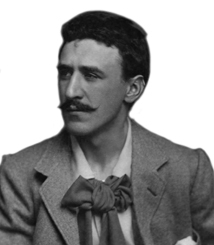
MACKINTOSH
1868 – 1928
Charles Rennie Mackintosh was born in Glasgow, Scotland in 1868.
In 1884 he began his studies with John Hutchinson, and also attended the night courses given at the Glasgow School of Art. In 1889 he became the architectural apprentice of Honeyman and Keppie.
Mackintosh’s influence is especially seen in three different types of architecture: public buildings, private houses, and tea rooms, many of which are found in Glasgow.
His philosophy of design was firmly rooted in the Scottish tradition. In fact Mackintosh ignored Greek and Roman architecture because they were not suited to the Scottish climate. He believed that a return to the Scots Baronial style, adapting it to modern society, could meet contemporary needs, and his buildings clearly demonstrate
this. Mackintosh created buildings that were noteworthy for their elegance and the clarity of their spatial concepts. The clever use of natural and artificial light demonstrated that as far as Mackintosh was concerned, all the details helped in creating the work. Together with his wife, her sister and his brother in law, Mackintosh
founded a group known as The Four or the Spook School, which was especially interested in furniture and home furnishings.
The group was praised by the critics, above all in the rest of Europe, and participated in many international exhibitions. They wished to distinguish themselves from the stylistic confusion and mediocrity of the Victorian era, and in this they were assisted by the English “Arts and Craft” movement. The Spook School was classified as an exponent of the Liberty Style; however the personal line of Mackintosh is considered to be closer to the Viennese school that developed around Hoffman, rather than the French and Belgian Art Nouveau whose decorative excesses he detested.
Mackintosh treated wood as a flexible, malleable material. He loved to cover his furniture with lacquer to hide the joints and unions, so that it stood out only for its definitive shape. This furniture design, rigidly geometric, preferable black, had a strong decorative effect.
He died in London in 1928.


